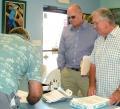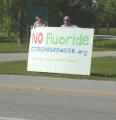Citizens for Safe Water Group will meet in front of the Greater Pine Island Water Department this Friday 11/ 16 at 4:00 to picket. The organizers is asking all who are not in favor of fluoride being put in Pine Island water to come and bring your signs with you. If you have any questions. Call Jack Mills at 283-1305
Pine Island - October 30, 2012
Around 3 PM, Tuesday, October 30, 2012, 20 members from the Citizens for Safe Water, Sate Water - Education and Advocacy for Pine Island, Matlacha and SW Florida gathered in front of the  Greater Pine Island Water Company to picket the Board’s decision to raise of the level of fluoride in the Pine Island drinking water.
Greater Pine Island Water Company to picket the Board’s decision to raise of the level of fluoride in the Pine Island drinking water.
Some of the protesters brought their young children to help hold anti fluoride  signs and wave at the passing cars on Pine Island Road in front of the Water Company.
signs and wave at the passing cars on Pine Island Road in front of the Water Company.
The GPIWA has approximately 6000 active members and the Citizens for Safe Water Group needed at least 10% of the active members to sign the petition in order have the subject of raising the level of Fluoride in Pine Island water go before the full membership for a vote.
 About half hour later Mark Dean and Jack Mills delivered approximately 800 sign petitions to the officials at the GPIWC. The signatures of the petitions must be verified as members of the GPIWA by the staff at the GPIWA who will check each name to make sure they are official members. Non-members are not permitted to vote.
About half hour later Mark Dean and Jack Mills delivered approximately 800 sign petitions to the officials at the GPIWC. The signatures of the petitions must be verified as members of the GPIWA by the staff at the GPIWA who will check each name to make sure they are official members. Non-members are not permitted to vote.
The petition is an effort to stop the GPIWA from adding additional fluoride to the drinking water on Pine Island.
Fluoride is not new to Pine Island water for the past 46-years; the water produced by the GPIWA for the membership has always contained fluoride. From 1966 – 1977 the fluoride levels in the drinking water received by the membership averaged 0.4 ppm. Beginning in 1993, when the water plant was moved onto Pine Island, the new wells have been producing  fluoridated water at levels that averaged 1.5 ppm. However, the GPIWA reverse osmosis water plant removes all but 0.15 - 0.4 ppm of the fluoride (1/5th to 1/2 of the optimum level). The fluoride enhancement process GPIWA is embarking on will simply add back 0.3 - 0.55 ppm as needed to bring the existing fluoride level up to the optimal 0.7 ppm.
fluoridated water at levels that averaged 1.5 ppm. However, the GPIWA reverse osmosis water plant removes all but 0.15 - 0.4 ppm of the fluoride (1/5th to 1/2 of the optimum level). The fluoride enhancement process GPIWA is embarking on will simply add back 0.3 - 0.55 ppm as needed to bring the existing fluoride level up to the optimal 0.7 ppm.
GPIWA‘s Board of Director’s, “sees this as an opportunity for all of their members to have the same benefits from fluoridation as the other residents in Lee County. Community water systems in the County that provide fluoridated water to their customers include Ft. Myers, Ft. Myers Beach, Cape Coral, and all areas served by Lee County Government Utilities.”
In Florida, 70% of Florida’s population, 13+ million Florida Residents are served by optimally fluoridated water, including the residents of Florida’s largest cities; Miami/Dade, Ft. Lauderdale, Jacksonville, Tampa, Tallahassee, Naples, etc. (Florida Dept. of Health).
 Most bottled waters now contain fluoride. The only water that does not contain fluoride is distilled. See below just a few names of bottled water that has added fluoride in it:
Most bottled waters now contain fluoride. The only water that does not contain fluoride is distilled. See below just a few names of bottled water that has added fluoride in it:
Crystal Mountain Spring Water and all the Crystal Waters; Culligan Water; Culligan (with Fluoride added) ; Culligan Purified Water; Culligan Spring Water; Walgreen's Drinking Water; Wal-Mart; Zephyrhills; Zodiac
The Citizens for Safe Water, Safe Water - Education and Advocacy for Pine Island, Matlacha and SW Florida seem to be particularly concerned for the health of the children and infants.
Their website citizensforsafewater.org quotes studies by The National Academy of Sciences, a U.S. non-profit corporation established in 1863 by Abraham Lincoln and responsible for reporting scientific research to the US government. In 2006, the National Research Council, a subsidiary of the NAS published a report titled, Fluoride in Drinking Water: A Scientific Review of EPA's Standards.
Among other of the NAS conclusions were;
“The committee's conclusions regarding the potential for adverse effects from fluoride at 2 to 4 mg/L in drinking water do not address the lower exposures commonly experienced by most U.S. citizens. The charge to the committee did not include an examination of the benefits and risks that might occur at these lower concentrations of fluoride in drinking water.”


















